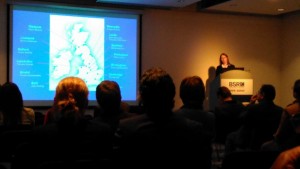EXCLUSIVE: Ssc Physiotherapist Expert Dr. Will Gregory Reports on British Society For Rheumatology (BSR) 2016 Conference
Written by |
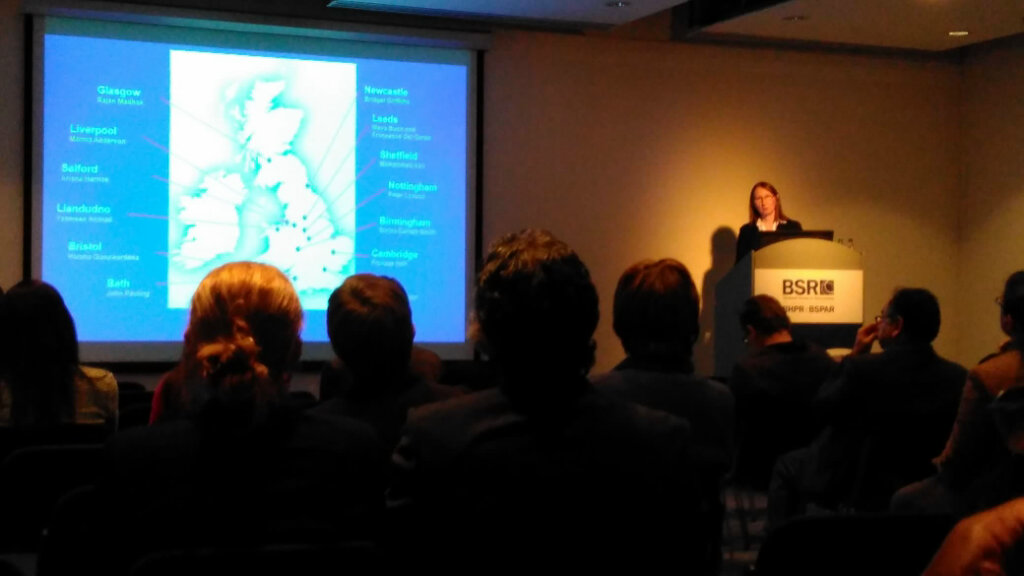
On Tuesday 26th through to the 28th of April, The British Society for Rheumatology held their annual conference, with this year’s venue being in Glasgow. Last year, it was held in Manchester, and I had the honour of being a presenter at one of the Ssc Scleroderma sessions. My presentation will follow in another blog post.
This year, there were three Ssc Scleroderma sessions held during the event. Scleroderma News has exclusive access to the sessions held on Wednesday, thanks to UK Ssc Physiotherapist expert, Will Gregory, who is based at the Salford Royal in Manchester, along with Prof Herrick’s team. We are extremely grateful to Dr. Gregory for sharing his notes with us.
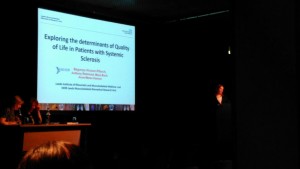 ‘12:30 Exploring the determinants of quality of life in systemic sclerosis.
‘12:30 Exploring the determinants of quality of life in systemic sclerosis.
Prof. Anne-Maree Keenan, University of Leeds. Presenting the work of Bigonya Alcacer-Pitarch
This interesting talk described the results of a series of questionnaires undertaken by people with scleroderma, attending the connective tissue clinic at Leeds Teaching Hospitals NHS Trust. 121 people completed the questionnaire, and this group reflected well the make up of the scleroderma cohort nationally (106 women, 15 men, average age of 57, an average disease duration of 9.5 years. 79% had limited, 20% had diffuse disease).
The researchers performed an analysis to come up with a model for the determinants of quality of life. The analysis produced scores out of 1 for impact on quality of life. They found 4 areas of direct impact:
- Physical function 0.45
- Depression 0.29
- Disease severity 0.16
- Anxiety 0.24
It was found that the area of indirect impact had an impact on these 4 direct areas, which then impacted quality of life. Indirect impacts included breathing difficulties, ulcers, foot problems and digestion problems.
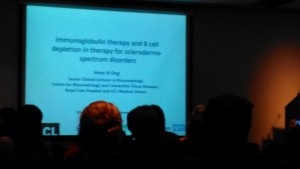 14.30 Immunoglobulin therapy and B-cell depletion in therapy for scleroderma-spectrum disorders.
14.30 Immunoglobulin therapy and B-cell depletion in therapy for scleroderma-spectrum disorders.
Dr. Voon Ong, Royal Free Hospital, London
Dr. Ong’s talk was about the rationale for using immunoglobulin therapy in people with scleroderma. He reminded us that scleroderma has overlapping pathology elements, namely, immune, vascular and fibrotic. His talk looked at two medications for refractory scleroderma — when a patient that doesn’t improve as expected with the standard drugs and treatment.
There are 4 research papers into the use of B-cell depleters. They were initially studied for their beneficial effects on the lung, and later, in papers for the skin and joint symptoms. The latest report was of the EUSTAR cohort and included an outcome of improved skin scores. There was mention of a new drug of this type being studied at the moment (the MEDI 551 study) that works earlier in the B-cell production pathway (not a scleroderma study).
Dr. Ong then went on to discuss intravenous immunoglobulins. These drugs have been assessed in 5 studies, where they showed improvement in skin scores. The effect on the lungs from this group of drugs has not been studied. Their effects on the gut have been very recently studied and benefits were reported
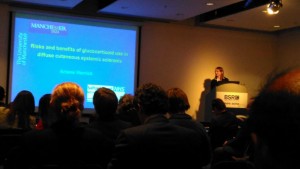 15.00: Risks and benefits of glucocorticoid use in diffuse systemic sclerosis.
15.00: Risks and benefits of glucocorticoid use in diffuse systemic sclerosis.
Prof. Ariane Herrick, Salford Royal NHS Foundation Trust, Manchester
There is a traditional perceived risk of renal crisis if using steroids in managing scleroderma. However, these drugs are used in other immune conditions to good effect. People with early diffuse scleroderma describe issues with painful and itchy skin, loss of function, fatigue and involvement of the musculoskeletal system.
It is thought that low dose steroids tablets would help alleviate these issues and if prescribed cautiously should not affect the kidneys. In the ESOS study (an observational study of Europe wide practice involving more than 300 people with scleroderma) 44 of them were taking steroids, so this is not an uncommon practice.
The PReDSS study will look at 72 people for a 6 month trial of medication or placebo. It commences recruitment in early 2017.
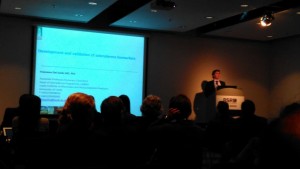 15.30 Development and validation of scleroderma biomarkers.
15.30 Development and validation of scleroderma biomarkers.
Prof. Francesco Del Gardo, University of Leeds, Leeds
Prof. Del Gardo is looking at better ways of assessing measurement of disease activity. These were described using 2 methods, through the use of blood test identified biomarkers and secondly, through imaging.
It has been found that some biomarkers do give disease activity similar to the current gold standards of the modified Rodnan skin score. There are a number of different markers being looked at. Samples have been taken across Europe from 658 people with scleroderma. It is hoped that these markers, once fully tested, may be of use not only in monitoring scleroderma activity in people with the condition, but also to aid in the diagnosis of progression from secondary Raynaud’s to scleroderma, allowing earlier treatment.
With regard to imaging, Prof. Del Gardo presented his teams work on laser produced images (optical coherence tomography) of the skin, and analysis of this, again, matched well to the skin score. Other centres are also studying this technology.’
Myself and the Scleroderma News team are extremely grateful to Will for sharing his very interesting notes of the second day of the conference, which covered ground breaking progress in the Ssc global field.
To find out more about Will, click here
Scleroderma News published the article ‘Fibrosis Improved In Ssc and IPF Models with Monoclonal antibody’ following the World Congress. Read it here
All in all, the Ssc findings presented at the Conference, are very encouraging for Ssc patients worldwide, with new therapeutics being tested, as well as, improved understanding of the day to day reality of the Ssc patient.



